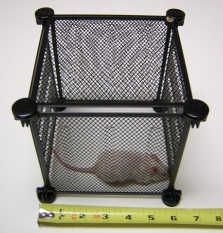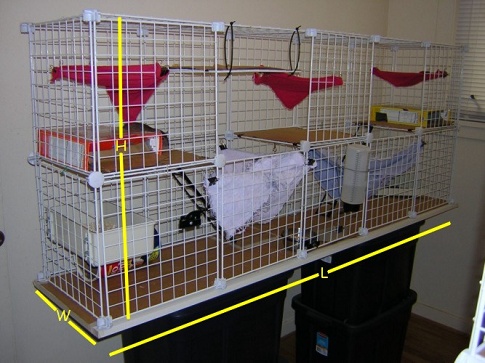
A Perspective on Cage Size
The Bare Minimums
How big should my mouse/rat cage be? Certainly at least as big as the minimums described below, but beyond that, as big as possible! In general, remember, (1) the bigger the cage, the better, and (2) compensate for less cage space with more time out.What are the absolute bare minimum floor space requirements for mice, rats, and humans? For mice and rats, laboratories require a minimum floor space of 15 and 70 in2, respectively, while for humans, prisons require a minimum floor space of 11,520 in2 (80 ft2). To compare between species, we normalize for size, taking weight as a measure of size and the average weight of a mouse, rat, and human to be 25, 500, and 68,040 g (150 lb), respectively. We find that rats (0.14 in2/g) and humans (0.17 in2/g) have similar floor space requirements, while mice (0.60 in2/g) need about four times more floor space than do rats or humans. Given how active mice are in comparison to rats or humans, this is not too surprising.
Getting a Perspective
We can now get a perspective on cage size by assuming that spatial comfort simply increases proportionally from the floor space minimums just discussed. The following tables list some select floor space standards, the human and mouse/rat equivalencies, and corresponding example mouse/rat cage dimensions. Cage heights are chosen to be about twice the body length of an adult mouse or rat. Always break up, and thereby maximize, cage height space with lots of hammocks, shelves, and other climbing surfaces.
| Floor space Standard | Floor space per Human, ft2 | Floor space per Mouse, in2 | Cage footprint, in x in | Height, in |
| Minimum (PRISON) | 80 | 15 | 6 x 3 | 6 |
| Typical Cage Calculator | 192 | 36 | 6 x 6 | 6 |
| Average Japanese | 300 | 56 | 6 x 9 | 6 |
| Average Western European | 400 | 75 | 6 x 13 | 6 |
| Average American | 600 | 113 | 6 x 19 | 6 |
| Martha Stewart | 20,000 | 3,750 | 6 x 625 | 6 |
| Floor space Standard | Floor space per Human, ft2 | Floor space per Rat, in2 | Cage footprint, in x in | Height, in |
| Minimum (PRISON) | 80 | 70 | 15 x 5 | 15 |
| Typical Cage Calculator | 257 | 225 | 15 x 15 | 15 |
| Average Japanese | 300 | 263 | 15 x 18 | 15 |
| Average Western European | 400 | 350 | 15 x 23 | 15 |
| Average American | 600 | 525 | 15 x 35 | 15 |
| Martha Stewart | 20,000 | 17,500 | 15 x 1,167 | 15 |

 Online mouse/rat cage calculators typically allow for a 6" x 6" x 6" living space per mouse (in the photo to the left, Elvis, 40 g, models this size living space) and a 15" x 15" x 15" living space per rat (in the photo to the right, Ann Taylor, 525 g, models this size living space); the corresponding living spaces per human are included in the tables above. Living in a cage might be comparable to living under house arrest. Martha Stewart was recently sentenced to 5 months of house arrest. Her house is purportedly 20,000 sq ft in size, and "Martha Stewart standards" are whimsically included in the tables above.
Online mouse/rat cage calculators typically allow for a 6" x 6" x 6" living space per mouse (in the photo to the left, Elvis, 40 g, models this size living space) and a 15" x 15" x 15" living space per rat (in the photo to the right, Ann Taylor, 525 g, models this size living space); the corresponding living spaces per human are included in the tables above. Living in a cage might be comparable to living under house arrest. Martha Stewart was recently sentenced to 5 months of house arrest. Her house is purportedly 20,000 sq ft in size, and "Martha Stewart standards" are whimsically included in the tables above.
In general, the bigger the cage, the better. Once you find the biggest cage you can afford, remember that less space can be compensated by more time out-- let the world be their playground! Compensate for less space with more time out.
Calculate the Human and Mouse/Rat Equivalencies for Your Cage
How big should my mouse/rat cage be? Certainly at least as big as the minimums described above, but beyond that, as big as possible! In general, remember, (1) the bigger the cage, the better, and (2) compensate for less cage space with more time out.How big should my mouse/rat cage be? When trying to answer this question, ask yourself, "How big of a home would I need before I went stir-crazy with x number of housemates and only an hour out each day?" Where does your mouse/rat cage fall in the above table? Complete the following worksheet to find out!
| 1 | Measure, in inches, the length (L), width (W), and height (H) of your mouse cage. Multiply L x W x H. This is the total volume of your cage. | 1 ____in3 |
| 2 | Divide line 1 by 36. | 2 ____in |
| 3 | Divide line 2 by the number of mice in the cage. | 3 ____in |
| 4 | Multiply line 3 by 6. | 4 ____in2 |
| 5 | Mulitply line 4 by 5.33. | 5 ____ft2 |
| Floor space Standard | Floor space per Human, ft2 | Floor space per Mouse, in2 | Cage footprint, in x in | Height, in |
| My Mouse Cage | [line 5] | [line 4] | 6 x [line 3] | 6 |
| 1 | Measure, in inches, the length (L), width (W), and height (H) of your rat cage. Multiply L x W x H. This is the total volume of your cage. | 1 ____in3 |
| 2 | Divide line 1 by 225. | 2 ____in |
| 3 | Divide line 2 by the number of rats in the cage. | 3 ____in |
| 4 | Multiply line 3 by 15. | 4 ____in2 |
| 5 | Mulitply line 4 by 1.14. | 5 ____ft2 |
| Floor space Standard | Floor space per Human, ft2 | Floor space per Rat, in2 | Cage footprint, in x in | Height, in |
| My Rat Cage | [line 5] | [line 4] | 15 x [line 3] | 15 |
A Sample Calculation

| 1 | Measure, in inches, the length (L), width (W), and height (H) of your rat cage. Multiply L x W x H. This is the total volume of your cage. 75" x 15" x 30" | 1 | 33750 in3 |
| 2 | Divide line 1 by 225. | 2 | 150 in |
| 3 | Divide line 2 by the number of rats in the cage. 4 rattie girls live in this cage | 3 | 37.5 in |
| 4 | Multiply line 3 by 15. | 4 | 562.5 in2 |
| 5 | Mulitply line 4 by 1.14. | 5 | 641.3 ft2 |
| Floor space Standard | Floor space per Human, ft2 | Floor space per Rat, in2 | Cage footprint, in x in | Height, in |
| My Rat Cage | 641.3 | 562.5 | 15 x 37.5 | 15 |
At a floor space per human of 641.3 ft2, my rattie girls live at about American floor space standards.